Reduction of impurity confinement time by combined heating of LHW and ECRH in EAST*
2021-07-30ZongXu许棕ZhenWeiWu吴振伟LingZhang张凌YueHengHuang黄跃恒WeiGao高伟YunXinCheng程云鑫XiaoDongLin林晓东XiangGao高翔YingJieChen陈颖杰LeiLi黎嫘YinXianJie揭银先QingZang臧庆HaiQingLiu刘海庆andEASTteam
Zong Xu(许棕) Zhen-Wei Wu(吴振伟) Ling Zhang(张凌) Yue-Heng Huang(黄跃恒)Wei Gao(高伟) Yun-Xin Cheng(程云鑫) Xiao-Dong Lin(林晓东) Xiang Gao(高翔)Ying-Jie Chen(陈颖杰) Lei Li(黎嫘) Yin-Xian Jie(揭银先)Qing Zang(臧庆) Hai-Qing Liu(刘海庆) and EAST team
1Advanced Energy Research Center,Shenzhen University,Shenzhen 518060,China
2Key Laboratory of Optoelectronic Devices and Systems of Ministry of Education and Guangdong Province,College of Optoelectronic Engineering,Shenzhen University,Shenzhen 518060,China
3Institute of Plasma Physics,Chinese Academy of Sciences,Hefei 230031,China
4University of Science&Technology of China,Hefei 230031,China
Keywords: LHW and ECRH heating,impurity confinement time,tungsten,small ELMs regime,EAST
1. Introduction
The high-Zimpurities’transport in plasma plays a significant role in present tokamak devices and future fusion devices such as International Thermonuclear Experimental Reactor(ITER)and China Fusion Engineering Test Reactor(CFETR).The high-Zimpurities in the plasma core can bring about two deleterious effects: one is strong radiation causing the central power loss,[1]the other is radiative cooling probably leading to plasma disruption.[2]High-Zimpurities in the central plasma therefore need to be controlled,especially in a machine with tungsten(W,Z=74)divertor plates,where physical sputtering at the striking points can inject tungsten into the main plasma.[3]
Previous research results in terms of experiments and simulations demonstrated that the impurity accumulation can be suppressed by intense central electrons heating.[4-7]Widely used in DIII-D,[8,9]ASDEX-U,[10]TCV,[11]etc., the on-axis ECRH can provide a more peaked electron temperature in plasma core so as to avoid the impurity accumulation. The LHW heating utilized on Tore Supra[12]and EAST[13,14]also shows an apparent reduction of core impurity confinement,due to the fact that LHW can heat central electron and generate turbulent transport. The study of the core impurity confinement properties in LHW and ECRH heated plasmas was inspired by the intense central electron heating.[15-17]Furthermore, in EAST, it is observed that the combined heating of LHW and ECRH can alleviate and avoid the effect of the sawtooth oscillation on the impurity transport.[18-20]The results regarding this combined heating for improving the core impurity confinement will be beneficial to the EAST long-pulse steady-state and high-performance operation with tungsten divertor.
The rest of the paper is structured as follows. In Section 2 described are the radio-frequency (RF) heating systems and the relevant diagnostics in EAST. In Section 3 provided are the experimental studies of the metallic impurity confinement properties in LHW and ECRH heated discharges. Finally in Section 4 summary and discussion are presented.
2. Experimental setup
This work was carried out on the full superconducting EAST tokamak, in which the vacuum chamber has a major radiusRof 1.85 m and minor radiusaof 0.45 m, the plasma cross-section elongation ratiokfrom 1.2 to 2, maximum plasma currentIPis 1 MA, maximum designed center toroidal field strengthBtis 3.5 T, and there are an advanced and flexible divertor configuration. The auxiliary heating systems have been successively developed since the first plasma was obtained in the 2006 campaign of EAST.[21]The RF heating methods, routinely used in EAST long-pulse and steadystate operated discharges, include two sets of LHW heating systems (a maximum power of 4 MW at 2.45 GHz, and a maximum power of 6 MW at 4.6 GHz),[22,23]two sets of ion cyclotron resonance frequency (ICRF) heating systems with a maximum total power of 12 MW in a frequency range of 25 MHz-70 MHz,[24]and two sets of ECRH systems with a maximum total heating power of 1 MW at 140 GHz.[25]Moreover,EAST has upgraded the plasma facing components(PFCs)to optimize the capacity of the heat load. The present main PFCs materials in EAST vacuum are W/Cu mono-blocks with active water-cooling for the upper divertor,molybdenum(Mo,Z=42)plates for the first wall,and SiC-coated graphite tiles for the lower divertor.In addition,there are metallic materials mounted for some special purposes,such as tungsten tiles for one of the guard limiters of LHW,copper(Cu,Z=29)for the RF antenna panels (including ICRF, LHW, and ECRH),and stainless steel (Fe,Z=26) for the dedicated ICRF antenna. The high-Zmetallic impurities in these components can be sputtered into the main plasma through the process of plasma surface interaction(PSI),degrading the plasma performance.
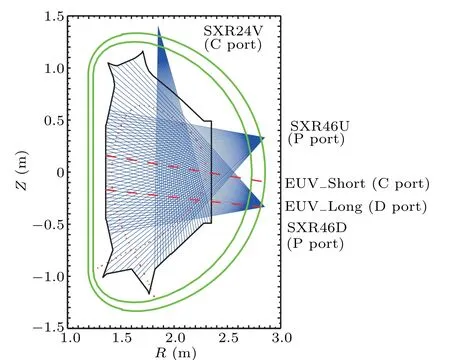
Fig. 1. Sight feild of soft x-ray imaging system (the blue lines) and viewing chords of two EUV spectrometers: EUV Short (dashed black line) and EUV Long(red lines)in EAST cross section.
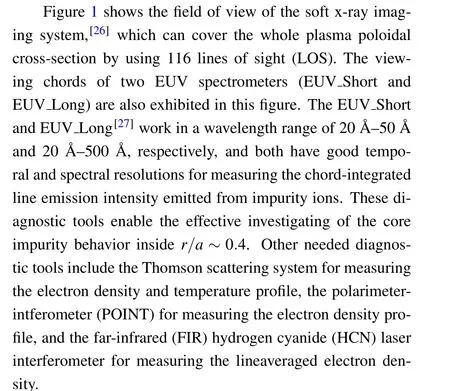
3. Experimental results
The studies of impurity confinement by using LHW and ECRH heating are carried out in L- and H-mode plasma on EAST.In this analysis,theτimpdefined below is used to estimate the efficiency of the heating methods for impurity accumulation control.
3.1. Spontaneous transient perturbations of impurities in EAST
Theτimpis the slowest time constant corresponding to the fundamental eigenfunction and can describe the decay of the final impurity distribution,[28,29]which has been used on many tokamak devices, such as C-mod,[30]TCV,[31]JET,[32]etc.Experimentally, theτimpis often deduced by so-called transient perturbation method (TPM), in which, the decay of transient impurity perturbation induced by the active impurityproducing techniques (such as, laser blow-off, pellets injection and gas puffing) is used for analyzing the impurity transport.[28,29,33]

Fig. 2. (a) Probability of transient impurity sputtering events versus Dgapout(distance of outer gap between limiter and last closed flux surface)in ohmically L-mode discharges (total 509 shots), and (b) probability of species of the sputtered impurities in ohmically(dark blue color)and LHW(red color)heated L-mode discharges(total 1433 shots)respectively.
As there is no active technique for injecting metallic impurities on EAST, the spontaneous transient perturbations of medium and high-Zimpurities are chosen for calculating theτimp. This spontaneous TPM has been successfully used to study the confinement properties of Fe and Cu in LHW-heated sawtooth-free plasma on EAST.[13]Such a spontaneous TPM of metallic impurities always occurs when the distance of outer gap between the limiter and the last closed flux surface(Dgapout) is relatively small. It is found that more than 80%of transient perturbation events happen whenDgapout<4 cm,such as in the ohmic plasma shown in Fig. 2(a). In the Lmode discharge with ohmic and pure-LHW heating,such transient perturbations are caused mainly by iron and copper ions as shown in Fig. 2(b). The transient perturbation of copper ions induced by the ‘hotspots’ from the LHW antenna panels are confirmed by high-speed CCD camera and EUV spectrometers.[13]However, the transient perturbation caused by molybdenum or tungsten ions is rarely observed because of the high sputtering threshold of molybdenum and tungsten ions. The shots with the perturbations of molybdenum and tungsten ions are mainly due to the dust-dropping or the interaction between the plasma particles and the testing samples.
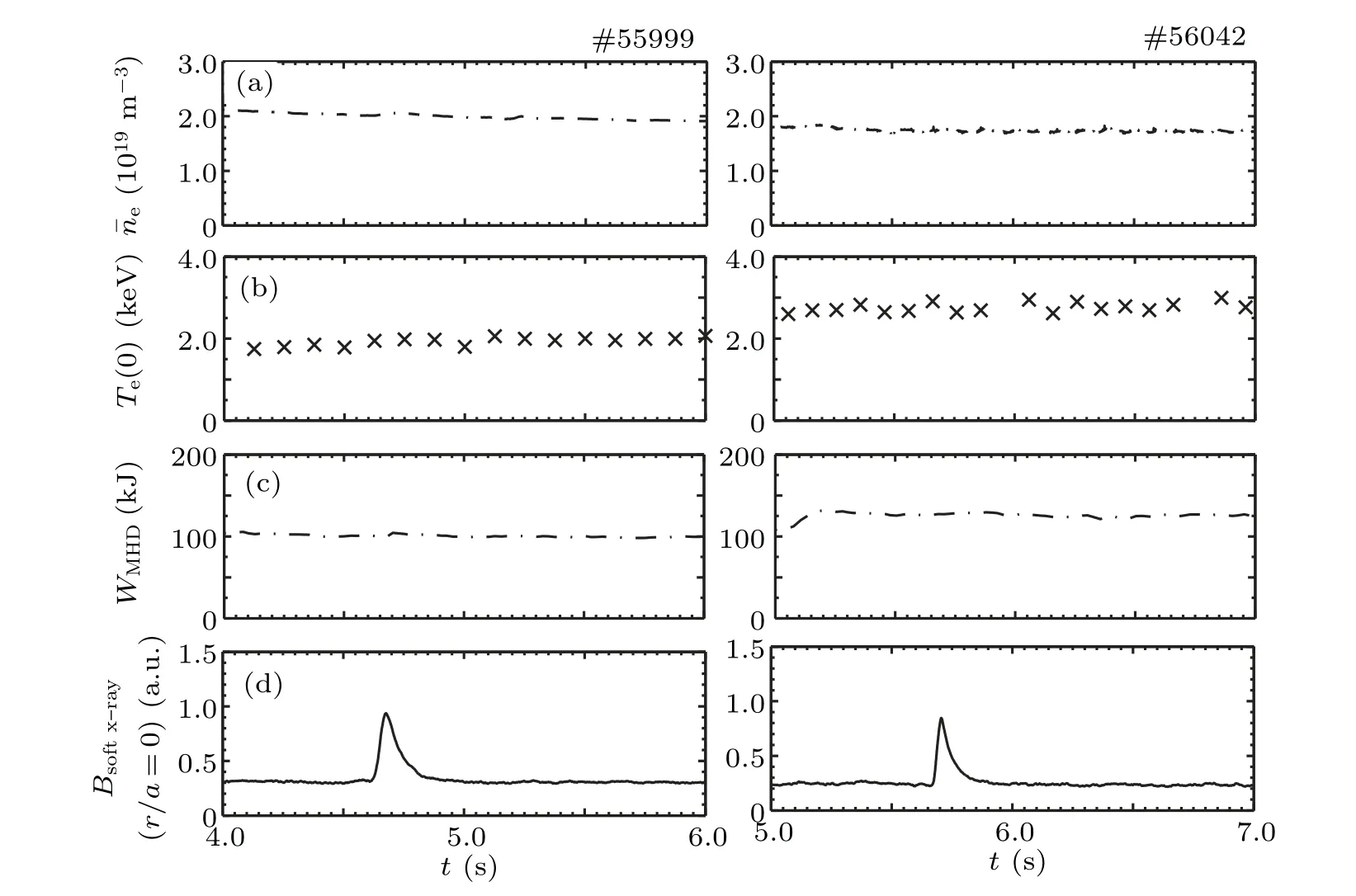
Fig. 3. Time traces of pulses # 55999 and #56042 during 4.0 s-6.0 s and 5.0 s-7.0 s, respectively: (a) line-averaged electron density ¯ne, (b) central electron temperature Te(0),(c)stored energy WMHD,and(d)soft x-ray emission from central chord.
The perturbation of impurity can be displayed by soft xray emission signals and EUV spectra. Taking shots #55999(LHW-only) and #56042 (LHW+ECRH) for example, in Fig.3(d),perturbations are revealed by the spikes on the central soft x-ray signal. The species of the sputtered impurities causing the spikes on the soft x-ray emission signal can be identified by the fast EUV spectrometers. The intensities of the line emissions from intrinsic impurities in shots #55999 and #56042, such as CVI(33.73 ˚A), LiIII(134.99 ˚A), FeXXII(117.17 ˚A), and CuXXVI(111.186 ˚A), are given in Fig. 4. It can be seen that the spikes on the intensity of FeXXII(#55999)and CuXXVI(#56042)emissions indicate that iron and copper ions penetrate deep into the plasma. Subsequently,the spikes decay nearly exponentially due to the diffusion of iron and copper ions out of the plasma. Therefore,it can be confirmed that the spikes on the soft x-ray signals are caused by iron ions for shot#55999 at 4.62 s and by copper ions for shot#56042 at 5.66 s respectively. The enhancement of intensity of CVIemission during the ECRH heating phase in shot #56042 is due to the thermally overloaded wall protection tiles(graphite tiles embedded on the high field side of the first wall) on the opposite to the ECRH antennas,can be seen in Fig.4(a).
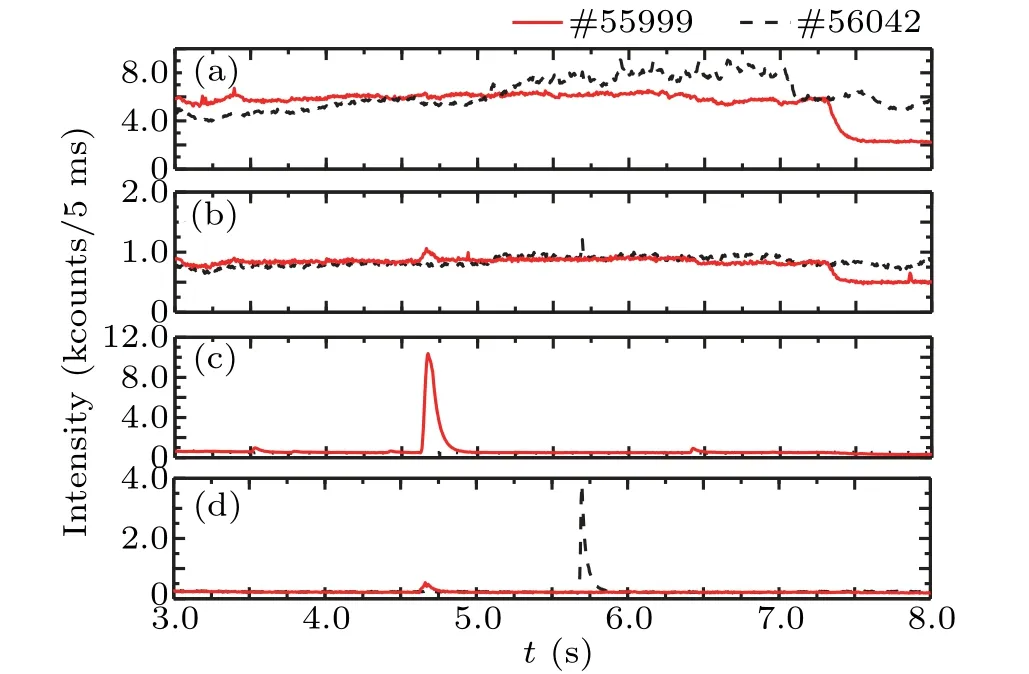
Fig.4. Time evolutions of intensities of line emissions from intrinsic impurities of shots#55999(solid red line)and#56042(dashed black line): (a)CVI 33.73 ˚A,(b)LiIII 134.99 ˚A,(c)FeXXII 117.17 ˚A,and(d)CuXXVI 111.186 ˚A.
The response of the plasma parameters to the perturbation of impurities is shown in Fig. 3. Generally, the TPM can be utilized on the central chord of soft x-ray emission signal only in the case that the effect of the impurity perturbation on electron density ¯neor electron temperatureTe(0)does not exceed 10%,[12,28]as the intensity of soft x-ray emission is determined by ¯neandTe(0)(∝¯n2eTγe,γ=2-5).As clearly seen from Fig.3,the plasma parameters for each of both shots are not obviously affected by transient perturbation of impurity events.
An exponential functionAe(-t/τimp)+Bis used to fit the decay phase of the soft x-ray signal. The relative error of the fitted decay time is less than 2%with the 95%confidence interval. It is found that a nearly constant decay time is obtained after the soft x-ray signal has decayed~20%as shown in Fig. 5(b). Figure 5(c) also shows the decay times of several chords of soft x-ray signal at different locations(r/a=0-0.4). It indicates that the decay time at the location ofr/a=0 is larger than at other locations, for the diffusion is lower in the inner plasma which thus governs theτimp. So,in order to guarantee that the decay phase is determined by theτimp, the fit must start till the brightness of central chord of soft x-ray emission has decayed about 20%-40%from its peak.

Fig.5. (a)Reconstruction of soft x-ray signal with function Ae(-t/τimp)+B in decay phase of spike(red dashed line),(b)decay time versus decay after peak,and(c)decay time calculated by fitting the different chords of soft x-ray signal near locations r/a=0-0.4.
3.2. Comparison between τimp in L-mode plasma with
LHW and LHW+ECRH heating
3.2.1. Dependence of τimp on electron density and total heating power



Fig.6.The τimp values versus ¯n0.43e in discharges with pure-LHW heating(red triangles)and with combined heating of LHW and ECRH(black triangles).


whereIPis in unit of MA,Btis in unit of T, ¯neis in unit of 1019m-3, andPtotalis in unit of MW. This combined heating method allows a higher electron density operation and can avoid the serious impurity accumulation, which is beneficial to high normalized poloidal beta(βP)plasma obtainment.[37]

Fig.7.Measuredτimp values versus n discharges with combined heating ofLHW andECRH.
3.2.2. Dependence of τimp on effective collisionality
Figure 8 shows the measuredτimpvalues and integrated power of turbulence (at wave numberk=12 cm-1in the regionr/a~0-0.4)versuseffective collisionality(atr/a~0-0.1) in L-mode plasmas with pure-LHW heating and with combined heating of LHW and ECRH. The effective collisionalityνeffis defined as the electron-ion collision frequency normalized to the electron curvature drift frequency, and expressed as[38]

whereS(t,f)refers to the spectrogram of microturbulence.As shown in Fig.8,the measuredτimpvalues have a tendency of increase with theνeffas shown by the dashed blue line. It is clearly shown that theτimpandνeffvalues are lower in the shots with combined heating of LHW and ECRH than that with pure-LHW heating.

Fig.8. Measured τimp values(circles)and integrated power of turbulence Sk,(green crosses)versus effective collisionality(νeff)at r/a ~0-0.1 in L-mode plasmas with pure-LHW heating (red) and with combined heating of LHW and ECRH(black).
In order to investigate the influence of the combined heating on core impurity confinement, two similar sawtooth-free L-mode discharges with different heating methods are chosen for comparison. The experimental conditions and plasma parameters of shots#59075 and#59093 are presented in Table 1,e.g.,IP=0.4 MA, ¯ne~2.5×1019m-3,Bt=2.3 T, and the same total heating power.Shot#59075 is heated by pure LHW withPLHW=1.9 MW, while shot #59093 is heated by LHW withPLHW=1.6 MW and ECRH withPECRH=0.3 MW.It is found that the combined heating of LHW and ECRH reduces theτimpfrom~62.78 ms to~48.33 ms,and improves the energy confinement timeτE(τE=WMHD/(Ptotal-dWMHD/dt))from 36.8 ms to 49.8 ms. The reducedτimpand improvedτEdemonstrate an effective control of impurity and energy confinement by the combined heating of LHW and ECRH. With this combined heating, theβPis improved from~0.55 to~0.9.
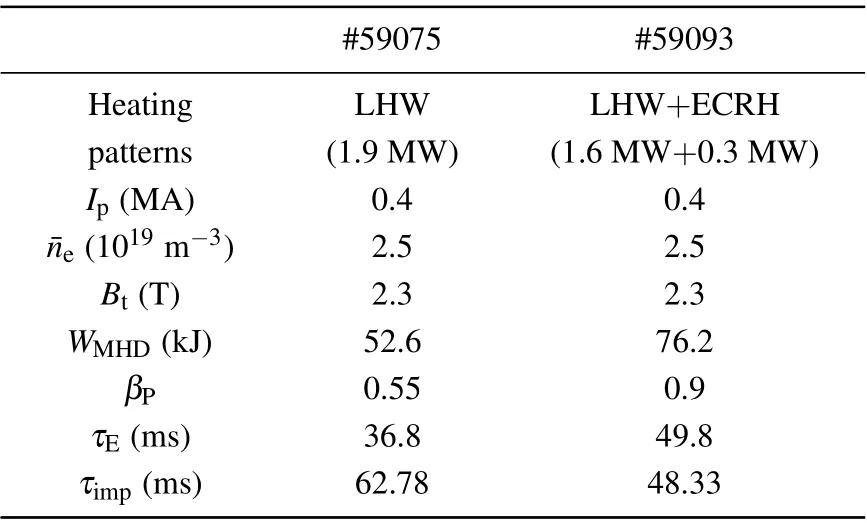
Table 1. Comparison between τimp in LHW (#59075) and inLHW+ECRH(#59093)heated L-mode plasmas.
The electron density and temperature profiles of the Lmode discharges with these two kinds of heating methods are shown in Fig. 9. The chosen shots have the parameters ofIP=0.45 MA, ¯ne~1.8×1019m-3, and the same total heating powerPtotal=2.0 MW.The red line indicates the discharge with the pure LHW heating(PLHW=2.0 MW),and the black line indicates the discharge with the combined heating of LHW and ECRH(PLHW=1.5 MW andPECRH=0.5 MW).As shown in Fig.9,in the case of combined heating of LHW and on-axis ECRH, a fairly peaked electron temperature profile and a relatively flat density profile in core plasma are achieved.The mechanism ofτimpreduction has not been clarified yet.This intense central electron temperature(Te(0))would be responsible for the shorterτimpin the shots with combined heating described above. On the one hand,the pump-out effect of intenseTe(0)[39]can flatten main ion density gradient and thus reduce neoclassical convection for impurities.[4]On the other hand, higherTe(0) and lower central electron density can reduce theνeffin the core plasma, and thus yielding a lowkelectron mode such as trapped electron mode (TEM) turbulent transport dominated.[15]An enhanced microinstability atk=12 cm-1in the central region(r/a ≤0.4)is observed by the tangential CO2laser collective scattering system[41]in the shots with combined heating of LHW and ECRH as shown by the green crosses in Fig. 8. The turbulent transport associated with these lowkelectron modes such as TEM can produce a decreased inward pinch and even an outward pinch of impurity,[42,43]yielding a shorterτimp.The TEM is often dominant in a low collisionality plasma which has been confirmed by gyrokinetic calculations in TCV.[44]In EAST,the TEM is also testified to be stronger than the electron temperature gradient (ETG) modes atr/a~0.4 by the integrated modeling calculations in this combined heating case.[45]
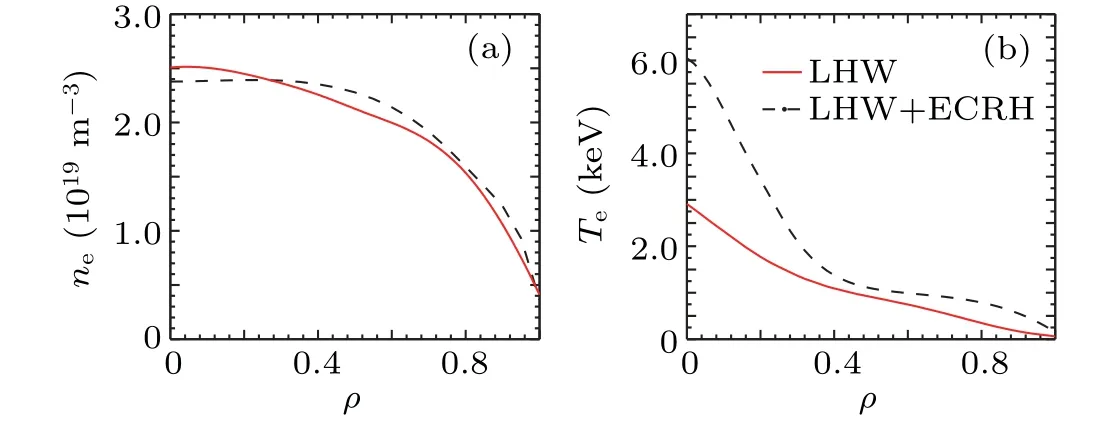
Fig. 9. (a) Electron density profiles and (b) temperature profiles of shots at IP =0.45 MA and ¯ne ~1.8×1019 m-3 with the same total heating power,where solid red line denotes the shot with source power of PLHW=2.0 MW,dashed black line represents the shot with source power of PLHW=1.5 MW and PECRH=0.5 MW,and ρ is the square root of normalized poloidal flux.
3.3. Impurity confinement in LHW and ECRH heated small ELMy H-mode plasmas
The analysis in sawtooth-free L-mode plasma shows that the core impurity confinement can be effectively reduced by combined heating of LHW and ECRH,which will be a good candidate heating method for the steady-state long-pulse and high-performance operation in EAST with tungsten divertor.In the 2017 EAST campaign, a long-pulse steady-state small ELMy H-mode with a duration of over 100 s and confinement factorH98>1.1 was achieved by using the pure RF heating(ICRF,LHW,and ECRH)with tungsten divertor.[46]It is also found that the preset long-pulse steady-state and highperformance discharges were always terminated by tungsten accumulation if the ECRH heating was turned off in advance.
The impurity confinement in H-mode plasmas heated by the combination of LHW heating and ECRH heating is explored on EAST,for the small-amplitude and high-frequency ELM regime (fELM>200 Hz) often occurs in the highβPdischarges.[47]The comparisons amongτimpand theβN(normalized plasma thermal pressure)in L-mode,high-enhancedrecycling (HER) mode, and small ELMy H-mode are performed and the results are shown in Fig. 10. This figure showsτimp= 30 ms-88 ms in L-mode discharges,τimp=140 ms-178 ms in HER H-mode discharges which operated withPLHW= 2 MW-4 MW, andτimp= 40 ms-80 ms in small ELMy H-mode discharges by using the combination of LHW heating and ECRH heating. Noticeably, theτimpin the small ELMy H-mode showing a level close to L-mode discharges is apparently shorter than that in HER H-mode discharges.[13,48,49]With the sufficient central heating and well controlled impurities[50]in this small ELMs regime, a higherβN~1.7 can be obtained.

Fig. 10. βN versus τimp in L-mode (black squares), HER H-mode (blue crosses),and small ELMy H-mode(red tringles).
Generally, in EAST routine discharges with this combined heating regime (PLHW>1.7 MW andPECRH>0.5 MW),small ELMy H-mode withfELM=0.5 kHz-1.4 kHz can be accessed. Shot #93624 is a typical discharge, which has the parameters ofIP= 0.4 MA, ¯ne~3.9×1019m-3,Bt= 2.55 T, source heating powerPLHW= 1.9 MW, andPECRH=0.5 MW aftert=2.92 s,which are shown in Fig.11.During this kind of combined heating phase, the edge coherent mode (ECM) is weakened, theTe(0) is about 3.2 keV,meanwhile a confinement factorH98~1.3 andβP~1.35 are achieved.
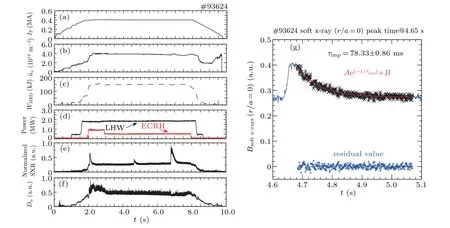
Fig. 11. Waveforms of shot #93624: (a) plasma current IP, (b) line-averaged electron density ¯ne, (c) stored energy WMHD, (d) LHW and ECRH heating power PLHW and PECRH,(e)normalized soft x-ray emission intensity from central LOS,(f)Dα intensity from upper divertor,and(g)impurity confinement time τimp during LHW+ECRH heating phase.
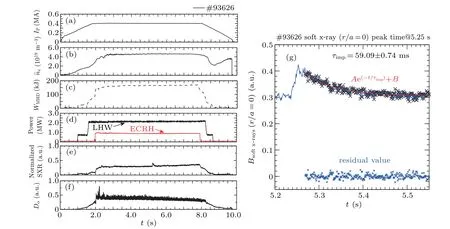
Fig.12. Waveforms of shot#93626: (a)plasma current IP,(b)line-averaged electron density ¯ne,(c)stored energy WMHD,(d)LHW and ECRH heating powers PLHW and PECRH, (e) normalized soft x-ray emission intensity from central LOS, (f) Dα intensity from upper divertor, and (g) the impurity confinement time τimp during LHW+ECRH heating phase.
During the steady state phase, one spontaneous impurity Fe burst (without influence on ELM) at 4.65 s is observed and used to calculate theτimp. As shown in Fig. 11(g), the calculatedτimpis about 76.33 ms. In this discharge, the ratio ofτE(~86.13 ms) toτimpreaches up to~1.1, this ratio level is nearly twice that in HER H-mode regime heated by pure LHW.[13]The above analysis shows the combined heating of LHW and ECRH accompanied with small amplitude and high frequency ELMs has a great capacity for flushing out the impurities,[51]suggesting a good candidate regime for realizing the steady state and high performance operation of EAST 1000 s goal in future.
It should be pointed out that in this regime,τimp(τE/τimp)can be further reduced (increased) by improving the total power of this combined heating, such as in shot #93626.This shot has the following parameters:IP=0.4 MA, ¯ne~4.5×1019m-3,Bt=2.55 T, and a higher source power of LHW and ECRH(PLHW=2.2 MW andPECRH=0.9 MW)as shown in Fig. 12. ThefELMin this shot is similar to that in#93624. The calculatedτimpin this shot (Fe burst at 5.25 s)is reduced to 59.09 ms,and theτE/τimpis improved to~1.24(τE~73.3 ms). Comparing with the shot#93624, the reduction of impurity confinement and energy confinement are associated with the very centrally peaked electron temperature(Te(0)~4.5 keV).The higherTe(0)can result in the increasing of electron thermal diffusivityχe[15]and impurity diffusivityDimp.[35]The increasedτE/τimpindicates that the enhancement of the impurity particles’ transport is more significant than that of the electron thermal transport by improving the total heating power in this regime.
Tungsten concentration (CW=nw/ne,nwandneare the tungsten ion density and electron density respectively, inside LCFS)is also investigated in this ELMy H-mode regime with LHW power scanning, such as in shot #88073. This shot has the parameters ofIP= 0.4 MA, ¯ne~3.3×1019m-3,Bt= 2.55 T,PECRH= 0.7 MW, andPLHWis scanned from 2 MW to 3.5 MW from 2.5 s to 7.5 s as shown in Fig. 13.In this small ELMs regime, it is clearly seen that theCWis well controlled at 10-5level (CWalways exceeds 10-4in type-I ELMy H-mode[52]) and can be further reduced from~5.0×10-5to~2.5×10-5with the decrease ofνeff. Asνeffis proportional toTe(0)-2·Zeff, theνeffis more sensitive toTe(0) than toZeff, which can be checked in Figs. 13(d)and 13(e). It is noted that theνeffjust decreases slightly after 3.8 s where decreasing rate of theTe(0)becomes slow andZeffincreases continuously. Two potential reasons of the slow change ofTe(0)after 3.8 s are given in Ref.[53]:one is that the increase ofZeffreduces the current drive efficiency, the other is that withPLHWincreasing, the parametric decay instability is enhanced,thus reducing the fraction of LHW power absorbed by plasma. Continuous growth ofZeffduring the LHW ramping-up phase is most likely caused by the impurity sputtering from the interactions between ELMs and surface or the‘hotspot’ often occurring in the case of highPLHW.[54]The increasedCWafter 6.2 s is due to tungsten droplet events. Using this droplet event, the tungsten confinement time is also evaluated to be about 68.5 ms. The results imply that the combined heating of LHW and on-axis ECRH with sufficient high power injection can reduce the collisionality,and thus controlling high-Zimpurities’accumulation.
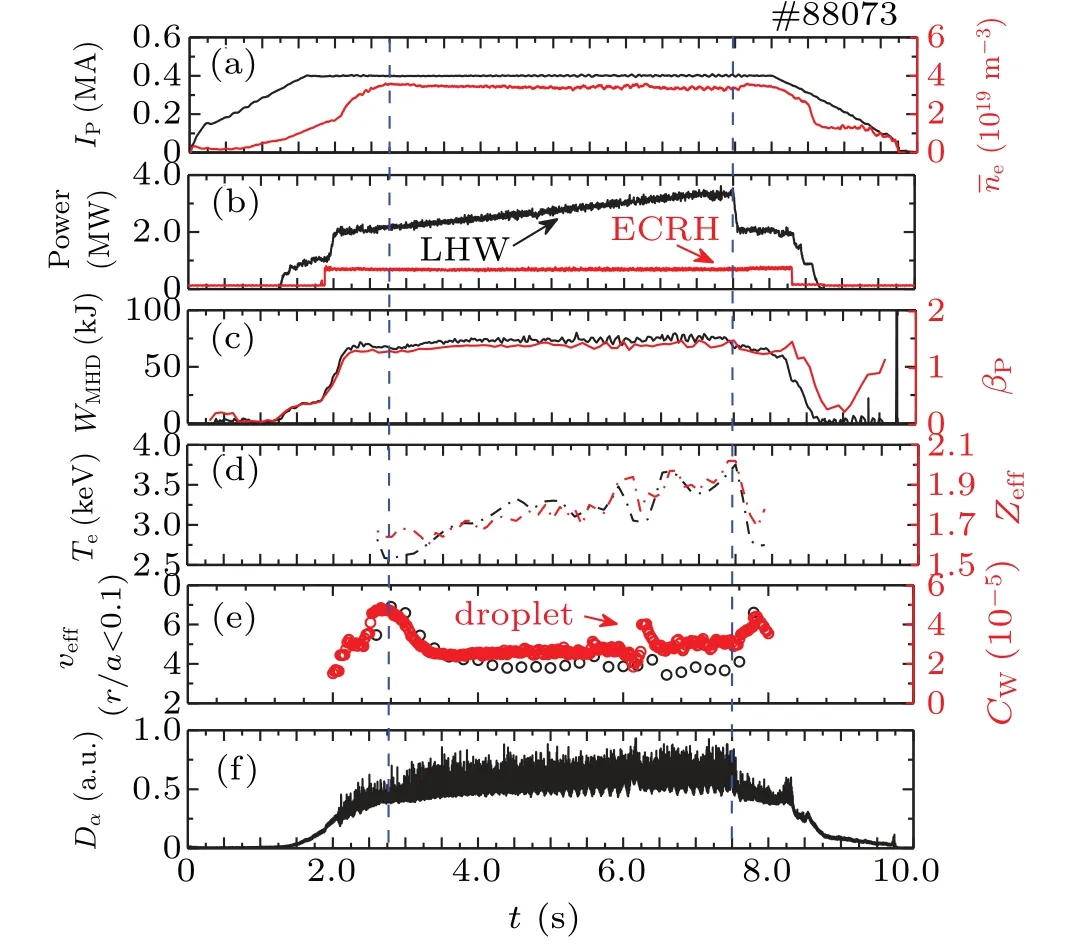
Fig.13. Waveform of shot#88073: (a)plasma current IP and line-averaged electron density ¯ne, (b) LHW and ECRH heating power PLHW and PECRH,(c)plasma stored energy WMHD and normalized poloidal beta βP,(d)central electron temperature Te(0)and effective charge number Zeff,(e)effective collisionality νeff inside r/a=0.1 and tungsten concentration CW, and (f) Dα emission from upper divertor. The abrupt increase of tungsten concentration at 6.2 s is due to tungsten droplet.
TheH98,τimp, and the maximum duration values of Lmode,HER H-mode,and small ELMy H-mode plasma heated by RF heating are listed in Table 2. It is found that the small ELM regime has a higherH98, a lowerτimpand the longer pulse duration than other H-mode regimes on EAST, which shows that the small ELM regime will be more competitive in exploring long-pulse steady-state and high-performance operation in future tokamak devices with high-Zmaterial PFCs like tungsten. More detailed analysis of the impurity and electron heat transport with small ELM regime is worth being performed, which can be helpful for further development on EAST.

Table 2. H98,τimp,and the longest pulse duration in EAST typical several regimes.
4. Summary and discussion
Using the spontaneous transient perturbations of impurities,the core impurity confinement characteristics in sawtoothfree L- and small ELMy H-mode plasma heated jointly by LHW and ECRH on EAST are investigated experimentally.It has been verified that the combined heating regime can provide a sufficient central electron heating and lead to a reducedνeffin core plasma,which is beneficial to inhibiting the high-Zimpurities’ accumulation. In the L-mode plasma,τimpin shot with combined heating of LHW and ECRH is apparently lower than that in the shot with pure LHW heating, even if these shots have the samePtotaland similar plasma parameters.The dependence ofτimpon the ¯neandPtotalin LHW+ECRH heated plasma is also investigated and compared with that in LHW-only heated plasma. In shots with the combined heating of LHW and ECRH,it is found thatτimpis weakly dependent on ¯ne, but strongly dependent onPtotaldominated by LHW heating. Surely, the on-axis ECRH heating plays an essential role in this performance. With the help of the increased central electron temperature provided by the synergy between LHW and ECRH can foster more LHW power deposition near the plasma center. Thus,a peaked electron temperature profile can be achieved,and relevant turbulent transport such as TEM will be dominating in lowνeffplasma and responsible for the enhanced transport observed in experiment. The results indicate that this combined heating method can avoid the serious impurity accumulation and is beneficial toβPimprovement.
Since highβPregimes are favorable for the access to the small ELM regime, the impurity suppressing effect by this combined heating regime is also testified in the H-mode plasma. Comparing with HER H-mode regime, an L-mode levelτimpand higherβNare obtained in small ELM regime heated by this combined heating method. It also shows that the further increasing of the total power of LHW and ECRH is beneficial toτimpreduction andτE/τimp(>1) improvement.The LHW power scanning experiments verify that the tungsten ion concentration can decrease by reducing theνeff.The above results indicate that the lowerνeffaccompanied with small amplitude and high frequency ELM has a great capacity in flushing out the impurities from core plasma. Compared with other regimes,the small ELM regime heated by this combined heating scenario will be beneficial to the steady high-performance long-pulse operations in future devices with high-Zmaterial(e.g.,tungsten)plasma-facing components.
猜你喜欢
杂志排行
Chinese Physics B的其它文章
- Numerical simulations of partial elements excitation for hemispherical high-intensity focused ultrasound phased transducer*
- Magnetic-resonance image segmentation based on improved variable weight multi-resolution Markov random field in undecimated complex wavelet domain*
- Structure-based simulations complemented by conventional all-atom simulations to provide new insights into the folding dynamics of human telomeric G-quadruplex*
- Dual-wavelength ultraviolet photodetector based on vertical(Al,Ga)N nanowires and graphene*
- Phase-and spin-dependent manipulation of leakage of Majorana mode into double quantum dot*
- Deep-ultraviolet and visible dual-band photodetectors by integrating Chlorin e6 with Ga2O3
